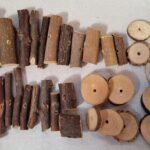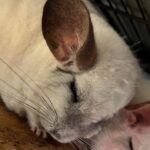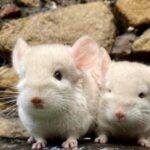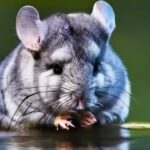Can My Chinchilla Have Straw in Their Cage As Bedding option: We all know straw is an agricultural byproduct provided in the regular diet of animals like Buffaloes and Cows. Straw is generally the dry stalks of wheat, paddy, oats, barley and other seasonal crops. Since they are available for very cheap price, people often wonder if they can use straw as bedding material in the cages and habitats of small pets. So, I decided to do some research on Can Chinchillas Have Straw in Their Cage, and here is what I have learned.
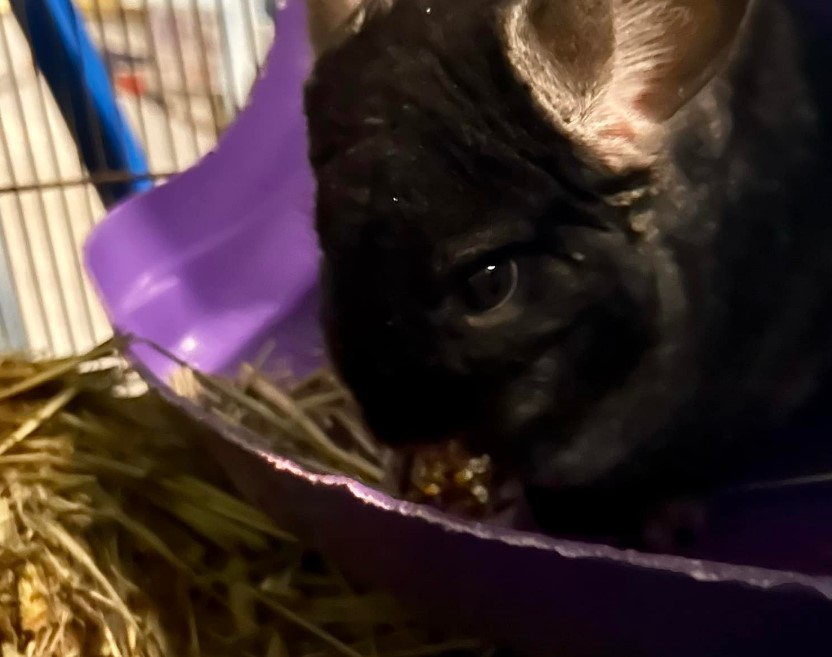
We know it can be challenging for the pet owners to choose the correct bedding for your new Chinchillas. If the bedding is not proper, your Chinchilla may suffer from serious health problems and mental issues. With that in mind, let us look at some pros and cons of having straw as a bedding option and food option for Chinchillas. We will also learn about appropriate chinchilla bedding and cheaper bedding options for your Chinchilla in the long run.
Can you use straw in a Chinchilla cage?
Straw doesn’t absorb the urine of animals well, and as a result, it doesn’t reduce the smell nor keeps the Chinchilla feet dry. Moreover, some of the Hard stalks might poke into your Chinchilla eye or body resulting in injuries in your pets. Thus, it would be best if you did not use straw in a Chinchilla cage.
As said in the previous section Straw is considered as one of the very cheaper and readily available option for bedding for animals but do you know is it safe for our Chinchillas? So, I decided to reach out to the chinchilla experts in the community, and here is what I have found about “Can My Chinchilla Have Straw in Their Cage As Bedding option”. Out of 90 responses we received, over 68% of them said straw is not suitable as a bedding option for your Chinchilla. However, the rest 32% of Chinchilla pet owners, have been using soft variants of straw as the bottom layer of bedding of chinchilla pets, and they have covered the same with other bedding materials to make it soft and absorbent.
Can Chinchillas have straw for bedding?
If you plan to use straw as the only bedding for your Chinchilla, it might not work out well for you and your Chinchilla. Straw doesn’t hold the moisture well, and as a result, your Chinchilla feet will remain wet, resulting in health issues like bumblefoot.
Apart from that, you are also likely to experience a strong odor of Chinchilla urine and poop as the bedding layer cannot trap the liquid well. If you are looking for cheaper Chinchilla bedding alternative, then hay and wood-shaving might be a better alternative.
Can Chinchilla have straw?
| Straw composition | Wheat Straw | Timothy Hay |
|---|---|---|
| Fibre | 41.6% | 65% |
| Protein | 3.9% | 8% |
| Calcium | 4% | 0.4% |
| Phosphorus | 0.6% | 0.2% |
| Fat | 1.4% | 2.6% |
Chinchillas can eat straw but straw doesn’t have enough fiber and protein that is needed by our chinchillas. If you check the table above, you can easily see that straw doesn’t hold much nutritional value when compared with hay. But at the same time, it is rich in calcium.
What kind of toys do chinchillas like to play with
Is straw good bedding for Chinchillas?
No, straw is definitely not the good bedding option for your chinchilla. However, it does have some advantages over regular bedding. These include:
Cheap price
Straw being an agricultural byproduct, straw is available at a cheaper price as compared to hay. Even though it is not a good option, you can use extra soft straw as the bedding base, especially when regular bedding is not readily available in your area. Price being the primary factor, you can use straw as the chinchilla base bedding when covering a large area in an outdoor enclosure or play area of your chinchilla.
Obtained quickly
Regular chinchilla bedding is not only costly but also not readily available everywhere. As chinchillas are not mainstream pets, some people might struggle to find their bedding at the store nearby. Or even if you buy online, it may take a long time for it to get delivered.
On the other hand, you can get an extra soft straw in almost any chinchilla pet store and hypermarkets. Thus, if you have a short supply of bedding, then you can use the straw for the base just as a filler and top it up with regular bedding or fleece for your chinchilla. However, you must ensure that you avoid wheat straw with hard stalks as it can hurt your chinchillas.
Is straw bad for chinchilla?
Straw was never meant to be a bedding material for chinchilla. Yes, straw is a good insulator, but at the same time, it doesn’t absorb moisture and can lead to mold and other issues.
So, you must never use straw as your only bedding for your chinchilla. Some common problems with straw as bedding are:
Non absorbent
Straw doesn’t hold moisture well. As chinchilla pee and poop a lot, the bed of your cage is likely going to remain wet at all times if absorbent material is not used. That can lead to various problems like bumblefoot, molds, and skin diseases in chinchilla. chinchilla prefer to stay warm and dry. Thus, using a bedding material that can absorb their waste and keep them dry and warm is recommended.
Doesn’t help with odor
Straw doesn’t hold the moisture well, which means the smell of ammonia from the urine of your chinchilla is going to spread across your room. That can be a nuisance for most chinchilla owners. Apart from that, the poop is also likely to break down and produce a foul smell if it stays on a wet surface. Thus, straw might not be the best bedding material, especially when you have housed your chinchilla inside your home.
Can lead to health issues
Straw has a lot of dust and sharp edges that can lead to respiratory and eye poke in chinchillas. The dust particles can cause allergy in human beings, and your chinchilla may also suffer from respiratory illness if they are sensitive towards it(Some chinchilla are).
Apart from that, sharp edges of the straw stalk can poke the eye of chinchillas as they try to burrow in the bedding. That can lead to eye infection and blindness in some cases. Thus, it is recommended to avoid straw as bedding, especially for chinchillas.
Affordable chinchilla bedding
If you want to go with only affordable bedding option, then you can go with hay and wood shavings.
Hay: Hay is not only stapled food for your chinchilla, but it can be used as supplementary chinchilla bedding as well. Also, Hay is much more absorbent than straw, and chinchilla can munch on it simultaneously. Thus, if you are looking for a cheap alternative for chinchilla bedding, then go with a bale of hay and lay it over the base of your chinchilla cage. You can also use newspaper or fleece in the chinchilla cage base to add the absorbent layer and top it with lots of hay.
Wooden Shavings: Wooden shavings are under-rated as far as chinchilla bedding materials are considered. If you are looking for affordable bedding for your chinchilla pet, then wooden shaving might be the best bet. However, you have to find a pet store or local stores to get you a large bag at a time for discounts.
Bonus tip: Most chinchilla bedding material like wood shavings and hay will need to be replaced and cannot be reused or recycled. So, reused materials can save you a lot of money on pets in the long run. And here comes the fleece liners. The best part about fleece liners is they can be washed and reused repeatedly for years to come. So, even if they are costly upfront, it saves a lot of money in the long-run.
Final Words:
Is straw the right choice for chinchilla? Definitely not! Straw might be a popular choice of food and bedding for some other animals, but it is definitely not the preferred choice for chinchilla. chinchillas have a sensitive respiratory system and other organs that can get harmed when you use straw as a bedding material. Thus, it is recommended to use other popular bedding and avoid straw in the first place.
Keep Reading:
